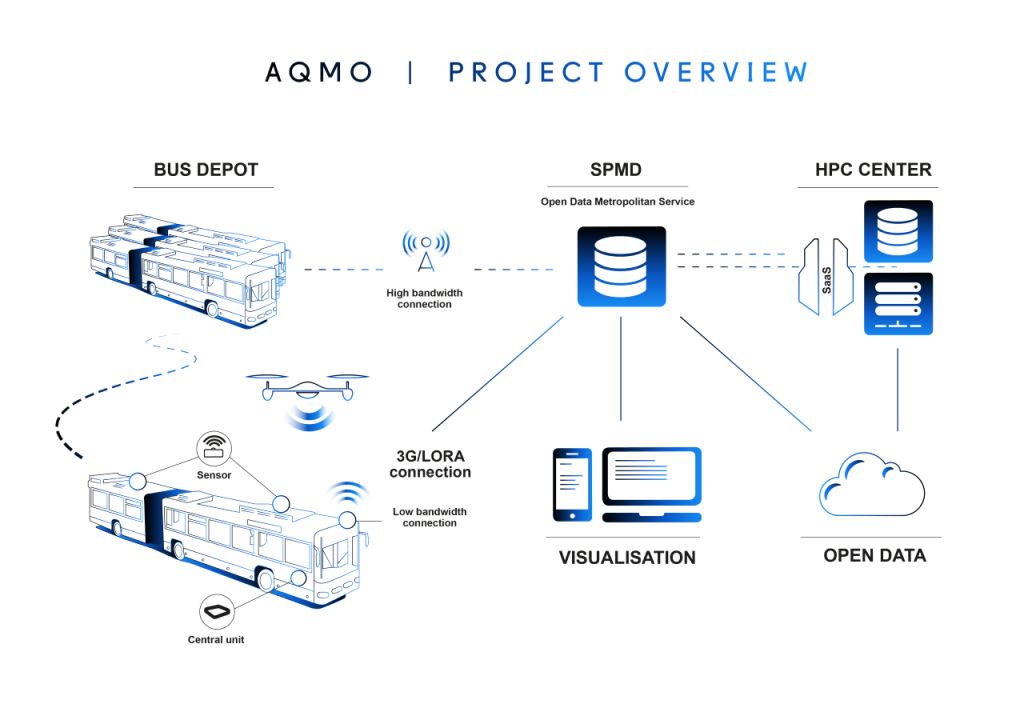Co-financed by the European Union through its CEF programme, AQMO addresses the air quality challenge, thanks to the development of a smart city pilot in the area of Rennes Metropole.
The project will provide an end-to-end urban platform that extends current practices in air quality measurements. The AQMO platform will provide citizens, local authorities, scientists and private companies with new data and innovative services based on computing simulation.

The AQMO project is divided into the following work packages:
WP1 – Management
The objective of the management work package is to set-up an effective management framework for the AQMO consortium to ensure progress of the project towards its planned objectives and respect of contractual commitments.
WP2 – Sensors platform
In this work package we design a mobile and flexible sensor platform to be embedded first in buses and then drones. This platform provides edge-computing capabilities in order to pre-process and store the data.
The design of the platform will allow to easily extend to new sensors by providing a detailed specifications of a wireless connection protocol. Multimodal communication to the cloud will be provided. The platform will come in two flavours:
- for buses for which energy is not strongly constrained;
- for drones based on energy efficient unit (for urgent measurement).
On the software side, the sensor platform will be remotely controlled in order to be able to submit new embedded tasks. A workflow for in-situ data processing will be proposed. Security issue will be integrated from the start. As designed, the platform will be open in order to be able to add new sensors as well as new data-processing (including machine learning techniques). The in-situ workflow management will allow to remotely submit new tasks to locally process the sensors data.
WP3 – Numerical simulation software
This work package defines the use of on-demand numerical simulation for pollution dispersion in a metropolis. It is not expected to develop new numerical models but to select ones to be used and ensure that all the data access and storage needed is set-up to be able to perform calculation on a remote supercomputer.
WP4 – HPC as a service
This work package targets the development of HPC Numerical Simulation as a service. The service provided should allow users to easily:
- Launch complex simulations which requires HPC infrastructure
- Address urgent requirements which requires quick response time
- Ensure that the input data required in such cases can be accessible without explicit data transfer to the (super)computing resources
The customers for such service do not have specific scientific engineering skills. Thus, both the applications and the computing resources should be abstracted from them.
To simplify the usage of the AQMO platform, we will prototype a prediction tool that will help users in the selection of the computing platform of choice (HPC centre, cloud or partner’s resources) and submit their jobs more easily. The prototype will leverage machine-learning techniques based on the analysis of simulation requests and logs. The tool will also propose APIs to be easily integrated in the AQMO platform.
In addition to the tools required to access the computing services, we will describe the exploitation costs of such an HPC as a service platform, to be able to define a coherent business model to bill its usage.
WP5 – Computing and storage workflow management, and visualization and citizen access
This work package develops a computing and storage workflow management system based on a uniform system representation that combines edges, data-centres, and supercomputers. The system will be a logically homogeneous global infrastructure based on connected nodes, for example the sensor platform instances; the primary database to which the sensors connect for short term storage; the infrastructure of the Rennes Metropole – Service Public Métropolitain de Ia Donnée for long term storage.
A secondary database at the IDRIS HPC centre will be set-up for a mid-term storage for simulation. Moreover, the activity will develop the data visualization access layer in order to provide scientists, citizens and public authorities the ability to plug in various analysis and visualization tools for air quality.
The core work will be to identify the set of tools and tools used configurations that should be supported by the platform. Two visualization aspects will be included: visualization of the sensors raw data; and the visualization of the numerical simulation result.
WP6 – Integration and technical coordination
This work package ensures that all components of the infrastructure are coherent and efficiently working together. It is in charge of building the complete Proof of Concept with at scale experimentations. Also, in this work package we address the publication of the date on the national and European Data Portals.
WP7 – Dissemination, impact and sustainability
This work package aims to disseminate the project’s results, maximize the project’s impact, raise awareness for citizen and policy makers and ensure sustainability and extension of the platform after the end of the project.
It will also produce the necessary documents to ensure sustainability, extension and replicability of the platform. In addition, all documentations required to produce a set of trainings will be produced. The university of Rennes 1 will develop these trainings as a result of the project.
Documentations also include software licenses and best practices documentation. The second year an external workshop will be organized in Rennes to demonstrate lively the platform to key stakeholders.

